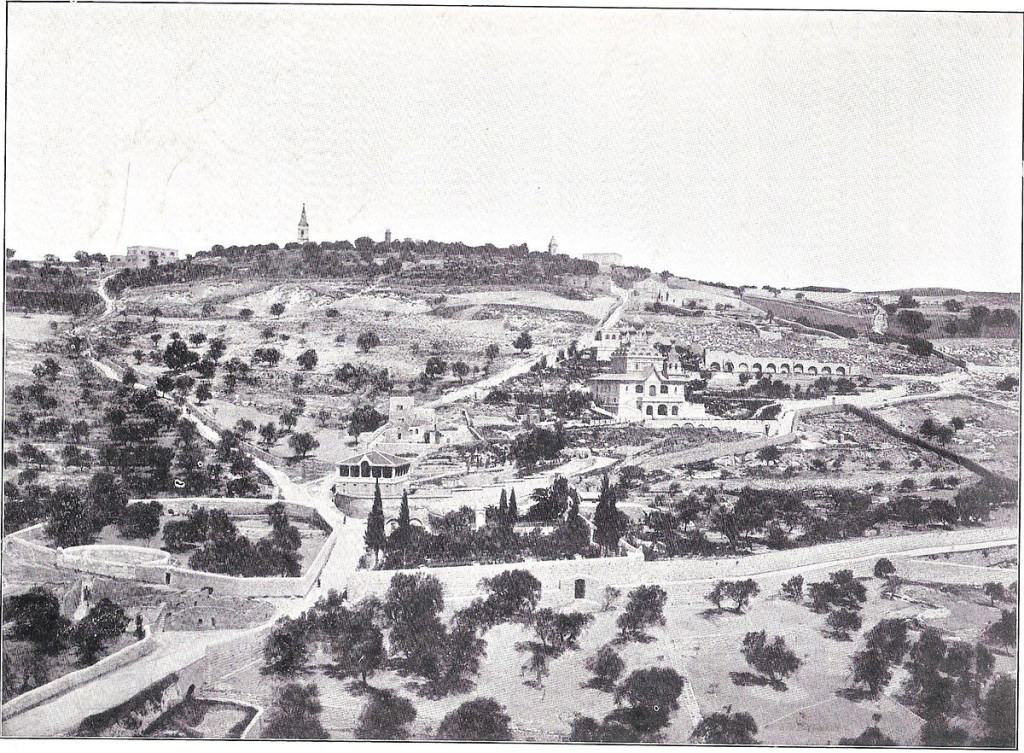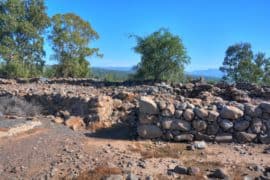There are two distinctive paths on the Mount of Olives, east of Jerusalem, both leading down to the Old City, intersecting at the Kidron Valley near the traditional Garden of Gethsemane. Both are thousands of years old, though paved with asphalt, with worn bed-rock showing here and there, indicating that the modern paths mirror the ancient ones. I have walked them both many times, alone, and with my students or with tour groups. With all the hodge-podge building “development” on the Mt of Olives in the 20th century they are difficult to show in a modern photograph, but you can see them very clearly in this 19th century photo. The northern path leads almost directly to the summit of the mountain, where the “Chapel of the Ascent” and the old Mt of Olives Hotel are today (where I first stayed in July, 1962). The southern path connects with Bethany and Bethphage, and today leads down the slope by the Seven Arches hotel–where all the tour buses park to photograph the Old City. It goes past Dominus Flevit (where Jesus wept), and like the northern path, ends near the Garden of Gethsemane at the Kidron. The northern path is referred to as the “ascent” and the southern as the “descent.”

When King David’s son Absalom sought to depose him we read that David left the city on foot, up the northern path called the “ascent” (מַעֲלֶה):
But David went up the ascent of the Mount of Olives, weeping as he went, barefoot and with his head covered. And all the people who were with him covered their heads, and they went up, weeping as they went….While David was coming to the summit, where people would prostrate themselves to God. . . (2 Samuel 15:30, 32).
Today is Palm Sunday, marking the day, according to the chronology of the Gospel of John, that Jesus rode a donkey down the slope of the Mount of Olives on the southern “descent” path from Bethany and Bethphage, hailed openly by the crowds for the first time as the Messianic “son of David”–a revolutionary move if there ever was one. (John 12:12-19). Although most of my academic colleagues would suggest this event never happened and the gospel writers insert it to “fulfill prophecy,” I am convinced quite the opposite is the case. It is Jesus who is self-consciously acting out or pantomiming the messianic prophecy of Zechariah 9:9 in the most deliberate manner–signaling the imminence of the Kingdom of God with the arrival of its rightful King! The gospel of Mark adds further details–with Jesus descending and ascending the Mt of Olives repeatedly during this last week of his life–staying with his disciples at Bethany, and every morning walking down into the city (Mark 11:1-14).
I have argued elsewhere, both in my book, The Jesus Dynasty, and in various posts on this blog, that Jesus was crucified on a Thursday, not a Friday, and that the place of his crucifixion was the summit of the Mount of Olives--not the traditional site of the Church of the Holy Sepulchre or the so-called “Garden tomb” north of Damascus Gate. The arguments for this location are based on our oldest text referring to the location of Jesus’ execution–one that connects it to the well-identified miphqad altar halfway up the slope of the Mt of Olives (Hebrews 13:10-13). I won’t rehearse here either the arguments for a Thursday rather than a Friday crucifixion–nor this location on the Mt of Olives–but you can read the full detailed arguments here: Jesus Died on a Thursday Not a Friday and Locating Golgotha.

My point today, on this Palm Sunday, is to think of the irony of Jesus riding down the southern path on the donkey as that fatal week began, and carrying his cross up the northern ascent path early Thursday morning–exiting out what is now called St Stephen’s Gate, stumbling along the way, crossing the Kidron, passing the Gethsemane area, and being executed at the summit–the “place of the skull.” Somehow the juxtaposition of the geography of these “Two Paths” echoes the poignant irony of both the events and the setting that Passover week of 30 CE.










Comments are closed.